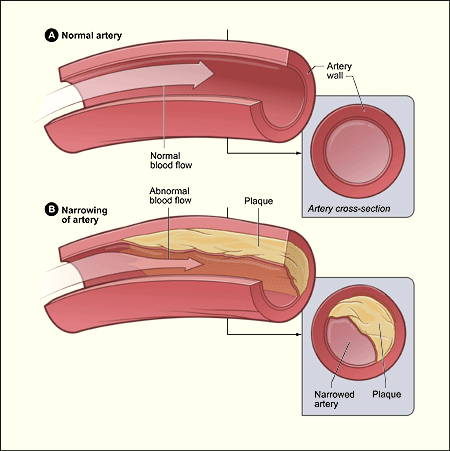Your heart is amazing!
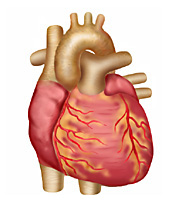
It's true. Your heart is an amazing part of your body.
Did you know?
-Your heart beats 100,000 times a day; 3,600,000 times a year and 2.5 billion times in your life. (1.)
-Despite only weighing about 11 ounces, your heart pumps 2,000 gallons (7,600 litres) of blood everyday through 60,000 miles (96,500 kilometres) of blood vessels. Yes, 60,000 miles! (2.)
-Over the course of your life, your heart will pump almost 1.5 million gallons (5,680,000 litres) of blood. That would be enough to fill 200 train tank cars. (3.)
Did you know?
-Your heart beats 100,000 times a day; 3,600,000 times a year and 2.5 billion times in your life. (1.)
-Despite only weighing about 11 ounces, your heart pumps 2,000 gallons (7,600 litres) of blood everyday through 60,000 miles (96,500 kilometres) of blood vessels. Yes, 60,000 miles! (2.)
-Over the course of your life, your heart will pump almost 1.5 million gallons (5,680,000 litres) of blood. That would be enough to fill 200 train tank cars. (3.)
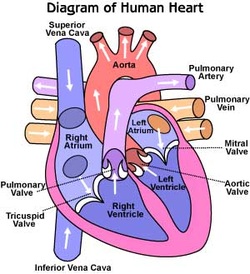
What does my heart do and how does it work?
Like your arms and legs, your heart is a muscle, but what makes this muscle special is that it pumps blood. Your heart circulates blood throughout your body and within the blood is oxygen from your lungs and nutrients from your digestive system. The oxygen and nutrients allow your body to function, grow and heal.
Your heart is located on the left side of your chest and is about the same size as your fist. To better understand how your heart works, cup your hands like you would if you were gently holding a small bird. Fill your hands with water and quickly make a fist with your right hand. You will pump water out of your hands in much the same manner your heart pumps blood.
Our heart is like two pumps in one. The right side gets blood from the body and then pumps it into your lungs. The left side gets blood from the lungs and then pumps it into your body. Blood travels through vessels and there are two kinds. The blood vessels that flow away from the heart are called arteries while the ones that flow toward the heart are called veins.
Like your arms and legs, your heart is a muscle, but what makes this muscle special is that it pumps blood. Your heart circulates blood throughout your body and within the blood is oxygen from your lungs and nutrients from your digestive system. The oxygen and nutrients allow your body to function, grow and heal.
Your heart is located on the left side of your chest and is about the same size as your fist. To better understand how your heart works, cup your hands like you would if you were gently holding a small bird. Fill your hands with water and quickly make a fist with your right hand. You will pump water out of your hands in much the same manner your heart pumps blood.
Our heart is like two pumps in one. The right side gets blood from the body and then pumps it into your lungs. The left side gets blood from the lungs and then pumps it into your body. Blood travels through vessels and there are two kinds. The blood vessels that flow away from the heart are called arteries while the ones that flow toward the heart are called veins.
What is heart disease?
Heart disease isn’t a single disease. Like cancer, heart disease can take on many forms and affect your health in many ways.
The most common type of heart disease is coronary artery disease (CAD). It kills the most people. In the US, it is also called coronary heart disease. CAD is when blood vessels within the heart get blocked or become narrower because of a build-up of plaque. This plaque is a mixture of fat, cholesterol and calcium. When there is too much plaque, this prevents fresh, oxygen-rich blood from getting to your heart and the consequence is that you have a heart attack.
Heart disease isn’t a single disease. Like cancer, heart disease can take on many forms and affect your health in many ways.
The most common type of heart disease is coronary artery disease (CAD). It kills the most people. In the US, it is also called coronary heart disease. CAD is when blood vessels within the heart get blocked or become narrower because of a build-up of plaque. This plaque is a mixture of fat, cholesterol and calcium. When there is too much plaque, this prevents fresh, oxygen-rich blood from getting to your heart and the consequence is that you have a heart attack.
Other types of heart
disease are carotid artery disease and peripheral arterial disease. The carotid
arteries are on both sides of your neck and they supply fresh blood to your
brain. When plaque builds up in them this is known as carotid artery disease.
If your carotid arteries get plugged, this interrupts the flow of blood to your
brain and may cause a stroke.
Peripheral arterial disease is when plaque reduces the flow of the major arteries that deliver oxygen-rich blood to your arms, legs and pelvis. If the blood flow to these parts is reduced, you may feel numbness and pain and might even develop a dangerous infection.
There are also many other types of heart disease that attack various parts of the heart itself, but they are similar in the way they can be prevented.
Peripheral arterial disease is when plaque reduces the flow of the major arteries that deliver oxygen-rich blood to your arms, legs and pelvis. If the blood flow to these parts is reduced, you may feel numbness and pain and might even develop a dangerous infection.
There are also many other types of heart disease that attack various parts of the heart itself, but they are similar in the way they can be prevented.
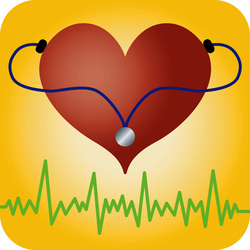
What can I do to prevent heart disease?
When it comes to heart disease, there are some factors you can control and some you cannot. (4.)
Factors you can’t control:
1. Age – your risk of heart disease increases as you get older.
2. Gender – male, over the age of 55 – female, after menopause.
3. Family history – your risk is increased if close members (parents, siblings or children) developed heart disease before age 55, or in the case of female relatives, before menopause.
4. Ethnicity – First Nations people and people of African or South Asian descent are more likely to have high blood pressure and therefore are at a greater risk of heart disease.
But there’s good news, too.
Here are the factors you can control:
1. Smoking
2. Diabetes
3. Being overweight
4. Physical inactivity
5. Excessive alcohol consumption
6. Stress
7. High blood pressure
8. High blood cholesterol
You can also control your diet, your anger and your intake of recreational drugs. Keep in mind, the more risk factors you have the higher your likelihood of developing or dying from heart disease.
In the case of my uncle, he smoked heavily, often drank to excess and smoked a lot of pot. He wasn’t overweight, but he rarely exercised and didn’t watch what he ate. He also drank a lot of strong coffee and espresso. I once saw him drink five cups of espresso first thing in the morning while he smoked half a dozen cigarettes. That was my uncle’s morning ritual for years. While there is evidence that some coffee can be good for your heart, I think that my uncle’s a.m. ritual damaged his cardiovascular health.
In the end, the consequences of my uncle’s choices caught up with him suddenly at the age of 42.
When it comes to heart disease, there are some factors you can control and some you cannot. (4.)
Factors you can’t control:
1. Age – your risk of heart disease increases as you get older.
2. Gender – male, over the age of 55 – female, after menopause.
3. Family history – your risk is increased if close members (parents, siblings or children) developed heart disease before age 55, or in the case of female relatives, before menopause.
4. Ethnicity – First Nations people and people of African or South Asian descent are more likely to have high blood pressure and therefore are at a greater risk of heart disease.
But there’s good news, too.
Here are the factors you can control:
1. Smoking
2. Diabetes
3. Being overweight
4. Physical inactivity
5. Excessive alcohol consumption
6. Stress
7. High blood pressure
8. High blood cholesterol
You can also control your diet, your anger and your intake of recreational drugs. Keep in mind, the more risk factors you have the higher your likelihood of developing or dying from heart disease.
In the case of my uncle, he smoked heavily, often drank to excess and smoked a lot of pot. He wasn’t overweight, but he rarely exercised and didn’t watch what he ate. He also drank a lot of strong coffee and espresso. I once saw him drink five cups of espresso first thing in the morning while he smoked half a dozen cigarettes. That was my uncle’s morning ritual for years. While there is evidence that some coffee can be good for your heart, I think that my uncle’s a.m. ritual damaged his cardiovascular health.
In the end, the consequences of my uncle’s choices caught up with him suddenly at the age of 42.
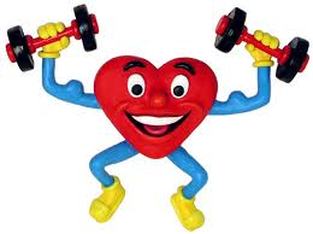
What can I do to have a healthy heart?
Your heart is a muscle. Like any other muscle, your heart will benefit from exercise.
Find a physical activity you enjoy that will get you breathing hard and sweating. Try jumping rope, dancing, running or any sport you enjoy. Even 30 minutes a day will do a lot for you and your heart.
I’ll be the first person to admit that I find exercise boring. I’ve tried gyms and exercise machines. They turn me off. I can’t stand the mind-numbing repetition.
Because it’s important for me to be active, I exercise in such a way that I don’t notice I’m exercising. I play floor hockey and I box. I enjoy both activities for their own sake plus I get my exercise.
Eating a variety of healthy foods will give your heart the nutrients it needs. A good way to do that is to include more fruits and vegetables in your diet.
Junk food and fast food are meant to be snacks. They’re not supposed to be the core of your diet. Junk food and fast food do nothing to nourish your body. In fact, they slowly hurt your organs.
Reducing your salt intake will help a lot. Humans need salt, but our North American diet gives us way more than we need. You don’t even need to sprinkle it on your food to be getting too much. A lot of the food we eat (potato chips, pizza, processed meats, soup) are loaded with salt.
Too much salt can hurt your heart because it raises your blood pressure which weakens your blood vessels. What happens when you squeeze a balloon full of water? The rubber gets weak from being stretched too far and the balloon might pop.
Because salt adds flavour, you might find your food tastes bland without it. Although it can take up to eight weeks for unsalted food to taste good, the long-term benefits outweigh the short-term discomfort. Try jazzing up your food with garlic, pepper, cumin, sage, vinegar, turmeric, rosemary, mint, ginger or hot peppers. Another trick is to add lemon, lime or orange either as juice or as zest, maybe both.
Cut back on the number of cigarettes you smoke. Smoking is poison for your heart.
Your heart is a muscle. Like any other muscle, your heart will benefit from exercise.
Find a physical activity you enjoy that will get you breathing hard and sweating. Try jumping rope, dancing, running or any sport you enjoy. Even 30 minutes a day will do a lot for you and your heart.
I’ll be the first person to admit that I find exercise boring. I’ve tried gyms and exercise machines. They turn me off. I can’t stand the mind-numbing repetition.
Because it’s important for me to be active, I exercise in such a way that I don’t notice I’m exercising. I play floor hockey and I box. I enjoy both activities for their own sake plus I get my exercise.
Eating a variety of healthy foods will give your heart the nutrients it needs. A good way to do that is to include more fruits and vegetables in your diet.
Junk food and fast food are meant to be snacks. They’re not supposed to be the core of your diet. Junk food and fast food do nothing to nourish your body. In fact, they slowly hurt your organs.
Reducing your salt intake will help a lot. Humans need salt, but our North American diet gives us way more than we need. You don’t even need to sprinkle it on your food to be getting too much. A lot of the food we eat (potato chips, pizza, processed meats, soup) are loaded with salt.
Too much salt can hurt your heart because it raises your blood pressure which weakens your blood vessels. What happens when you squeeze a balloon full of water? The rubber gets weak from being stretched too far and the balloon might pop.
Because salt adds flavour, you might find your food tastes bland without it. Although it can take up to eight weeks for unsalted food to taste good, the long-term benefits outweigh the short-term discomfort. Try jazzing up your food with garlic, pepper, cumin, sage, vinegar, turmeric, rosemary, mint, ginger or hot peppers. Another trick is to add lemon, lime or orange either as juice or as zest, maybe both.
Cut back on the number of cigarettes you smoke. Smoking is poison for your heart.
To learn more about the benefits of exercise, watch this video:
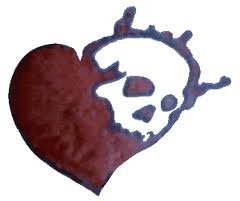
How deadly is heart disease?
-According to the Canadian Heart and Stroke Foundation, there are about 70,000 heart attacks in Canada every year. That works out to one every 7 minutes.
-Heart disease is the number 1 killer of women in Canada and the number 2 killer of men.
-In the United States, heart disease is the number 1 killer of both men and women. (5.)
-In 2008, over 616,000 Americans died of heart disease. Heart disease caused almost 25% of deaths—almost one in every four—in the United States. (6.)
-In 2010, coronary heart disease alone was projected to cost the United States $108.9 billion. This total includes the cost of health care services, medications, and lost productivity. (7.)
-According to the Canadian Heart and Stroke Foundation, there are about 70,000 heart attacks in Canada every year. That works out to one every 7 minutes.
-Heart disease is the number 1 killer of women in Canada and the number 2 killer of men.
-In the United States, heart disease is the number 1 killer of both men and women. (5.)
-In 2008, over 616,000 Americans died of heart disease. Heart disease caused almost 25% of deaths—almost one in every four—in the United States. (6.)
-In 2010, coronary heart disease alone was projected to cost the United States $108.9 billion. This total includes the cost of health care services, medications, and lost productivity. (7.)
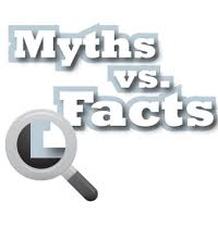
Myths
-Working hard is the same as getting exercise. It’s not. There are lots of jobs that are physically demanding, but they're not exercise unless your heart rate is elevated.
-Healthy foods have no taste. Bacon tastes amazing. But then again so does fresh squeezed orange juice, strawberries in milk, carrots from your garden, salmon steak and cold watermelon on a white hot day. Look for healthy foods you enjoy.
-You don’t have to worry about your heart. You can just have a stent put in if ever you have a heart attack. This is a surprisingly common myth that's nothing more than an insane gamble. How do you know a heart attack won’t kill you instantly?
-Working hard is the same as getting exercise. It’s not. There are lots of jobs that are physically demanding, but they're not exercise unless your heart rate is elevated.
-Healthy foods have no taste. Bacon tastes amazing. But then again so does fresh squeezed orange juice, strawberries in milk, carrots from your garden, salmon steak and cold watermelon on a white hot day. Look for healthy foods you enjoy.
-You don’t have to worry about your heart. You can just have a stent put in if ever you have a heart attack. This is a surprisingly common myth that's nothing more than an insane gamble. How do you know a heart attack won’t kill you instantly?
For more information about heart disease, please consult the following sources:
References
1. Parramon’s Editorial Team. 2005. Essential Atlas of Physiology. Hauppauge, NY: Barron’s Educational Series, Inc.
2. Daniels, Patricia, et. al. 2007. Body: The Complete Human. Washington, D.C.: National Geographic Society.
3. Avraham, Regina. 2000. The Circulatory System. Philadelphia, PA: Chelsea House Publishers.
4. Heart and Stroke Foundation pamphlet, Taking Control, page 2.
5. http://www.nhlbi.nih.gov/health/health-topics/topics/cad
6. Miniño AM, Murphy SL, Xu J, Kochanek KD. Deaths: Final data for 2008. National Vital Statistics Reports; vol 59 no 10. Hyattsville, MD: National Center for Health Statistics. 2011.
7. Centers for Disease Control and Prevention. Racial/Ethnic and Socioeconomic Disparities in Multiple Risk Factors for Heart Disease and Stroke—United States, 2003. MMWR. 2005;54(5):113–117.
1. Parramon’s Editorial Team. 2005. Essential Atlas of Physiology. Hauppauge, NY: Barron’s Educational Series, Inc.
2. Daniels, Patricia, et. al. 2007. Body: The Complete Human. Washington, D.C.: National Geographic Society.
3. Avraham, Regina. 2000. The Circulatory System. Philadelphia, PA: Chelsea House Publishers.
4. Heart and Stroke Foundation pamphlet, Taking Control, page 2.
5. http://www.nhlbi.nih.gov/health/health-topics/topics/cad
6. Miniño AM, Murphy SL, Xu J, Kochanek KD. Deaths: Final data for 2008. National Vital Statistics Reports; vol 59 no 10. Hyattsville, MD: National Center for Health Statistics. 2011.
7. Centers for Disease Control and Prevention. Racial/Ethnic and Socioeconomic Disparities in Multiple Risk Factors for Heart Disease and Stroke—United States, 2003. MMWR. 2005;54(5):113–117.
Bibliography
-Alberta Health Services, Apple, Fall 2011, Issue 5.
-Alberta Health Services, Apple, Winter 2012, Issue 6.
-http://www.jumpropeforheart.ca
-http://kidshealth.org/kid/htbw/heart.html
-http://www.nhlbi.nih.gov/health/health-topics/topics/cad/
-http://www.heartandstroke.ca
-http://www.cdc.gov
-Alberta Health Services, Apple, Fall 2011, Issue 5.
-Alberta Health Services, Apple, Winter 2012, Issue 6.
-http://www.jumpropeforheart.ca
-http://kidshealth.org/kid/htbw/heart.html
-http://www.nhlbi.nih.gov/health/health-topics/topics/cad/
-http://www.heartandstroke.ca
-http://www.cdc.gov
Pictures provided by these websites
-Inside the heart http://www.wereyouwondering.com/what-does-your-heart-do/
-Outside view of heart http://kidshealth.org/kid/htbw/heart.html
-Plaque in the arteries http://www.nhlbi.nih.gov/health/health-topics/topics/cad/
-Healthy heart http://www.sheringhamprimary.norfolk.sch.uk
-Skull and heart http://www.verbivorehere.wordpress.com
-Myths versus Facts http://www.schoox.com
-Inside the heart http://www.wereyouwondering.com/what-does-your-heart-do/
-Outside view of heart http://kidshealth.org/kid/htbw/heart.html
-Plaque in the arteries http://www.nhlbi.nih.gov/health/health-topics/topics/cad/
-Healthy heart http://www.sheringhamprimary.norfolk.sch.uk
-Skull and heart http://www.verbivorehere.wordpress.com
-Myths versus Facts http://www.schoox.com
